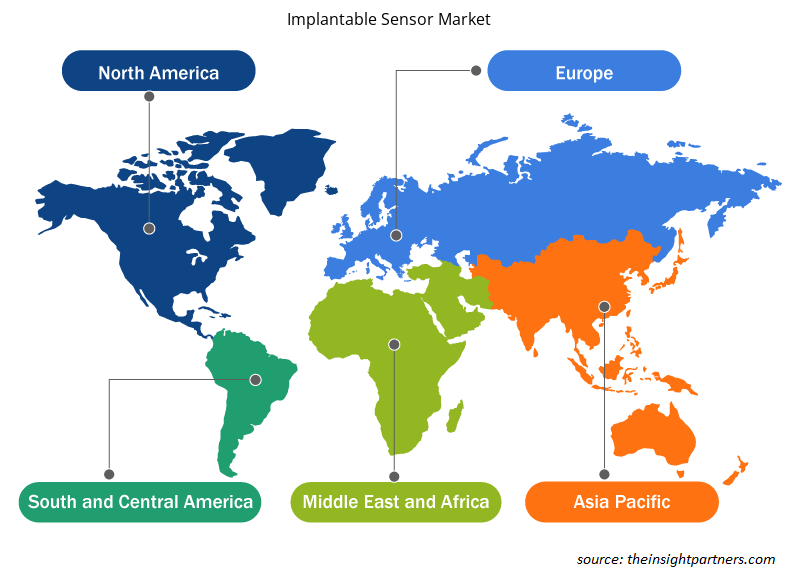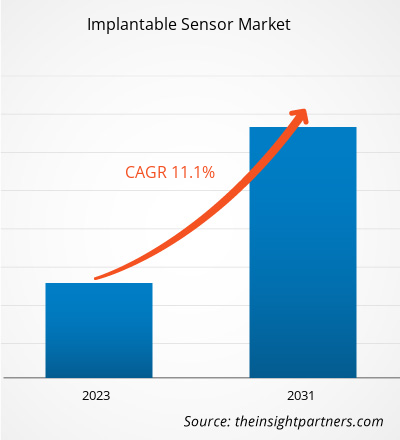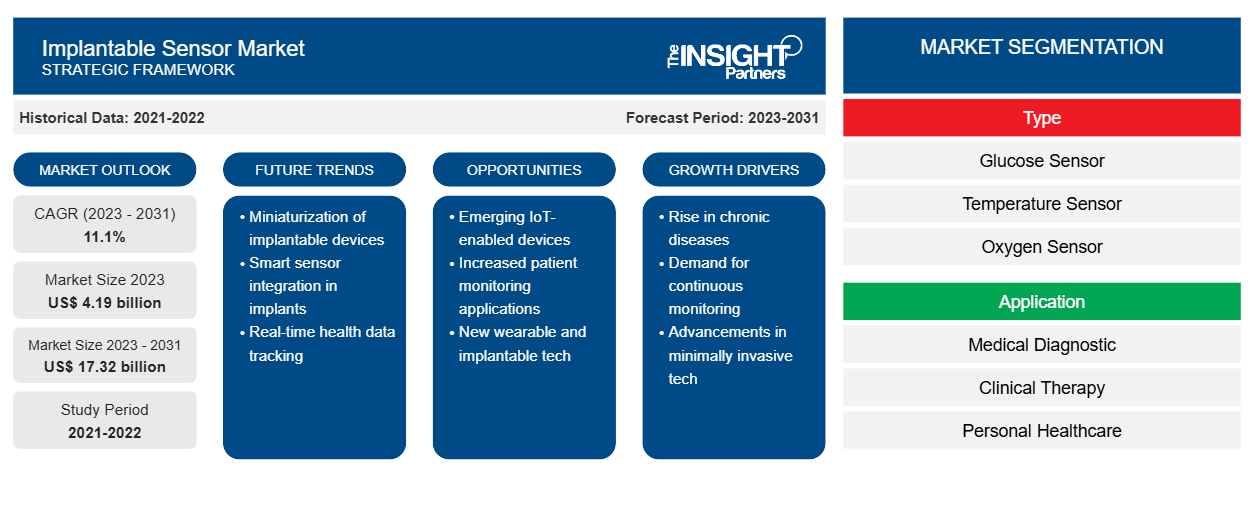من المتوقع أن يصل حجم سوق أجهزة الاستشعار القابلة للزرع إلى 4.19 مليار دولار أمريكي في عام 2023 ومن المتوقع أن يصل إلى 17.32 مليار دولار أمريكي بحلول عام 2031.
ومن المتوقع أن يسجل معدل نمو سنوي مركب بنسبة 11.1٪ حتى عام 2031. ومن المرجح أن يظل تطوير علاجات النطق الجديدة، وطرق الاتصال البديلة، وزيادة فحوصات السمع عند الأطفال حديثي الولادة، واستخدام الذكاء الاصطناعي في علاجات النطق من أهم اتجاهات سوق أجهزة الاستشعار القابلة للزرع.
تحليل سوق أجهزة الاستشعار القابلة للزرع
أجهزة الاستشعار القابلة للزرع هي أجهزة طبية صغيرة توضع داخل الجسم لمراقبة المعلمات الفسيولوجية المختلفة للجسم، مثل درجة الحرارة، والضغط، ومستوى الجلوكوز، أو تركيز الدواء. وقد حظيت مثل هذه المنتجات باهتمام كبير في صناعة الرعاية الصحية. الجهاز قادر على توفير بيانات في الوقت الحقيقي لمتخصصي الرعاية الصحية لتحسين إدارة الحالات الطبية المزمنة أو مراقبة ما قبل/بعد الجراحة. ومن المتوقع أن يؤدي الانتشار المتزايد للحالات الطبية المزمنة إلى تعزيز تطوير منتجات جديدة ودفع سوق أجهزة الاستشعار القابلة للزرع.
نظرة عامة على سوق أجهزة الاستشعار القابلة للزرع
يُعزى نمو السوق إلى بعض العوامل الرئيسية الدافعة، مثل زيادة انتشار الأمراض المزمنة والاعتماد المتزايد على تقنيات الرعاية الصحية المتنقلة. ومع ذلك، فإن انخفاض معدل التبني في البلدان الناشئة هو عامل رئيسي يعيق نمو السوق. يتم تقسيم سوق أجهزة الاستشعار القابلة للزرع العالمية حسب المنطقة إلى أمريكا الشمالية وأوروبا وآسيا والمحيط الهادئ والشرق الأوسط وأفريقيا وأمريكا الجنوبية والوسطى. في أمريكا الشمالية، تعد الولايات المتحدة أكبر سوق لأجهزة الاستشعار القابلة للزرع. يُعزى نمو المنطقة إلى وجود لاعبين رئيسيين في السوق وتطورات المنتجات المتزايدة. بالإضافة إلى ذلك، من المتوقع أن تحفز التطورات المستمرة للمنتجات نمو سوق أجهزة الاستشعار القابلة للزرع في أمريكا الشمالية. ومن المتوقع أن تمثل منطقة آسيا والمحيط الهادئ أسرع نمو في سوق أجهزة الاستشعار القابلة للزرع.
قم بتخصيص هذا التقرير ليناسب متطلباتك
ستحصل على تخصيص لأي تقرير - مجانًا - بما في ذلك أجزاء من هذا التقرير، أو تحليل على مستوى الدولة، وحزمة بيانات Excel، بالإضافة إلى الاستفادة من العروض والخصومات الرائعة للشركات الناشئة والجامعات
- احصل على أهم اتجاهات السوق الرئيسية لهذا التقرير.ستتضمن هذه العينة المجانية تحليلاً للبيانات، بدءًا من اتجاهات السوق وحتى التقديرات والتوقعات.
محركات وفرص سوق أجهزة الاستشعار القابلة للزرع
تزايد استخدام تقنيات الرعاية الصحية المتنقلة لصالح السوق
إن التبني المتزايد لتقنيات الرعاية الصحية المتنقلة يحدث ثورة في تقديم الرعاية الصحية من خلال توفير وصول ملائم إلى المعلومات الطبية وأدوات المراقبة والاتصال من خلال الهواتف الذكية والأجهزة الطبية القابلة للارتداء وغيرها. ويتمثل هذا الاتجاه في تمكين الأفراد من تولي مسؤولية الصحة وتسهيل مراقبة المرضى عن بعد وتحسين الوصول إلى خدمات الرعاية الصحية وتحسين تجربة المريض بشكل عام. تعد الاضطرابات المزمنة مثل مرض السكري وضغط الدم واكتشاف عدم انتظام ضربات القلب من المحركات الرئيسية لحصة سوق أجهزة الاستشعار القابلة للزرع العالمية.
الدعم الحكومي للتكنولوجيات الطبية – فرصة فيسوق أجهزة الاستشعار القابلة للزرع
تتزايد الاستثمارات في أنشطة البحث والتطوير الطبي في جميع أنحاء العالم. وفقًا لتقرير الاستثمارات الأمريكية في البحث والتطوير الطبي والصحي 2016-2020، زادت الاستثمارات في الولايات المتحدة للبحث والتطوير الطبي والصحي بمقدار 48.5 مليار دولار أمريكي أو 42٪ من عام 2016 إلى عام 2020، وزادت الاستثمارات الفيدرالية بمقدار 21.4 مليار دولار أمريكي أو 53.5٪ من عام 2016 إلى عام 2020. كما زاد الاستثمار في التكنولوجيا الطبية بنسبة 36.49٪ من عام 2016 إلى عام 2020. وبالتالي، يُنظر إلى الدعم الحكومي في تطوير التقنيات الطبية على أنه يترك تأثيرًا إيجابيًا على سوق أجهزة الاستشعار القابلة للزرع، حيث إنه يوفر فرصة لمصنعي الأجهزة الطبية.
تقرير تحليل تجزئة سوق أجهزة الاستشعار القابلة للزرع
إن القطاعات الرئيسية التي ساهمت في اشتقاق تحليل سوق أجهزة الاستشعار القابلة للزرع هي النوع والتطبيق والمستخدم النهائي.
- بناءً على النوع، ينقسم سوق أجهزة الاستشعار القابلة للزرع إلى أجهزة استشعار الجلوكوز وأجهزة استشعار درجة الحرارة وأجهزة استشعار الأكسجين وأجهزة استشعار الضغط وغيرها. احتل قطاع البرمجيات حصة سوقية أكبر في عام 2023. احتل قطاع مستشعر الجلوكوز الحصة الأكبر من السوق في عام 2023، في حين من المتوقع أن يسجل قطاع مستشعر الأكسجين أعلى معدل نمو سنوي مركب في السوق خلال فترة التوقعات.
- من حيث التطبيق، يتم تقسيم السوق إلى التشخيص الطبي والعلاج السريري والرعاية الصحية الشخصية والتصوير. استحوذ قطاع التشخيص الطبي على أكبر حصة من السوق في عام 2023؛ ومع ذلك، من المتوقع أن يسجل قطاع الرعاية الصحية الشخصية أعلى معدل نمو سنوي مركب في السوق خلال الفترة 2024-2031.
- من حيث المستخدمين النهائيين، ينقسم السوق إلى مستشفيات وعيادات ومراكز تشخيص. سيطر قطاع المستشفيات على السوق في عام 2023، ومن المتوقع أن يسجل أعلى معدل نمو سنوي مركب في السوق خلال الفترة المتوقعة.
تحليل حصة سوق أجهزة الاستشعار القابلة للزرع حسب المنطقة الجغرافية
ينقسم النطاق الجغرافي لتقرير سوق أجهزة الاستشعار القابلة للزرع بشكل أساسي إلى خمس مناطق: أمريكا الشمالية، ومنطقة آسيا والمحيط الهادئ، وأوروبا، والشرق الأوسط وأفريقيا، وأمريكا الجنوبية/أمريكا الجنوبية والوسطى.
سيطرت أمريكا الشمالية على سوق أجهزة الاستشعار القابلة للزرع. وفقًا للجمعية الأمريكية للسكري، سيعيش ما يقرب من 38.4 مليون أمريكي، أو ما يقرب من 11.6٪ من السكان، مع اضطراب السكري في عام 2021، ومن بينهم كبار السن أو أولئك الذين تبلغ أعمارهم 65 عامًا أو أكبر، يشكلون غالبية الحصة. نظرًا لارتفاع حالات الإصابة بمرض السكري في المنطقة، احتلت أمريكا الشمالية الحصة الأكبر في عام 2022. إن الميل نحو المنتجات المتقدمة تقنيًا ووجود لاعبين عالميين في السوق من العوامل التي تساهم في هيمنة سوق أجهزة الاستشعار القابلة للزرع في أمريكا الشمالية. ومن المتوقع أن تنمو منطقة آسيا والمحيط الهادئ بأعلى معدل نمو سنوي مركب في السنوات القادمة.
رؤى إقليمية حول سوق أجهزة الاستشعار القابلة للزرع
لقد قام المحللون في Insight Partners بشرح الاتجاهات والعوامل الإقليمية المؤثرة على سوق أجهزة الاستشعار القابلة للزرع طوال فترة التوقعات بشكل شامل. يناقش هذا القسم أيضًا قطاعات سوق أجهزة الاستشعار القابلة للزرع والجغرافيا في جميع أنحاء أمريكا الشمالية وأوروبا ومنطقة آسيا والمحيط الهادئ والشرق الأوسط وأفريقيا وأمريكا الجنوبية والوسطى.

- احصل على البيانات الإقليمية المحددة لسوق أجهزة الاستشعار القابلة للزرع
نطاق تقرير سوق أجهزة الاستشعار القابلة للزرع
| سمة التقرير | تفاصيل |
|---|---|
| حجم السوق في عام 2023 | 4.19 مليار دولار أمريكي |
| حجم السوق بحلول عام 2031 | 17.32 مليار دولار أمريكي |
| معدل النمو السنوي المركب العالمي (2023 - 2031) | 11.1% |
| البيانات التاريخية | 2021-2022 |
| فترة التنبؤ | 2023-2031 |
| القطاعات المغطاة | حسب النوع
|
| المناطق والدول المغطاة | أمريكا الشمالية
|
| قادة السوق وملفات تعريف الشركات الرئيسية |
|
كثافة اللاعبين في سوق أجهزة الاستشعار القابلة للزرع: فهم تأثيرها على ديناميكيات الأعمال
يشهد سوق أجهزة الاستشعار القابلة للزرع نموًا سريعًا، مدفوعًا بالطلب المتزايد من المستخدم النهائي بسبب عوامل مثل تفضيلات المستهلكين المتطورة والتقدم التكنولوجي والوعي المتزايد بفوائد المنتج. ومع ارتفاع الطلب، تعمل الشركات على توسيع عروضها والابتكار لتلبية احتياجات المستهلكين والاستفادة من الاتجاهات الناشئة، مما يؤدي إلى زيادة نمو السوق.
تشير كثافة اللاعبين في السوق إلى توزيع الشركات أو المؤسسات العاملة في سوق أو صناعة معينة. وهي تشير إلى عدد المنافسين (اللاعبين في السوق) الموجودين في مساحة سوق معينة نسبة إلى حجمها أو قيمتها السوقية الإجمالية.
الشركات الرئيسية العاملة في سوق أجهزة الاستشعار القابلة للزرع هي:
- شركة انالوج ديفايسز
- شركة ديكسكوم
- شركة جلوسينس المحدودة
- شركة هونيويل الدولية
- ميدترونيك
- شركة NXP لأشباه الموصلات
إخلاء المسؤولية : الشركات المذكورة أعلاه ليست مرتبة بأي ترتيب معين.

- احصل على نظرة عامة على أهم اللاعبين الرئيسيين في سوق أجهزة الاستشعار القابلة للزرع
أخبار سوق أجهزة الاستشعار القابلة للزرع والتطورات الأخيرة
يتم تقييم سوق أجهزة الاستشعار القابلة للزرع من خلال جمع البيانات النوعية والكمية بعد البحث الأولي والثانوي، والتي تتضمن منشورات الشركات المهمة وبيانات الجمعيات وقواعد البيانات. فيما يلي قائمة بالتطورات في سوق أجهزة الاستشعار القابلة للزرع والاستراتيجيات:
- في ديسمبر 2023، أصبحت شركة Medstar أول شركة في العالم تزرع جهاز استشعار Cordella لعلاج قصور القلب المتقدم. يرسل المستشعر ضغط الشريان الرئوي للمريض عن بعد عبر مستشعر ميكانيكي كهربائي دقيق لاسلكي إلى فريق الأطباء. باستخدام هذه البيانات في الوقت الفعلي، يمكن للأطباء تعديل الأدوية والعلاجات بشكل استباقي بهدف تقليل حالات دخول المستشفى بسبب قصور القلب. (المصدر: MedStar Health، بيان صحفي، 2024)
- في فبراير 2022، أعلنت شركة Ascensia Diabetes Care، وهي شركة عالمية متخصصة في رعاية مرضى السكري، أن شريكتها Senseonics Holdings, Inc. حصلت على موافقة من إدارة الغذاء والدواء الأمريكية (FDA) على الجيل القادم من نظام Eversense® E3 Continuous Glucose Monitoring (CGM). تخطط Ascensia لجعل مستشعر Eversense E3، الذي يمكن استخدامه لمدة تصل إلى 6 أشهر، متاحًا للمرضى في الولايات المتحدة (المصدر: Ascensia Diabetes Care Holdings AG.، Senseonics, Inc. Press Release/Company Website/Newsletter، 2024)
تقرير سوق أجهزة الاستشعار القابلة للزرع والتغطية والنتائج المتوقعة
يوفر تقرير "حجم سوق أجهزة الاستشعار القابلة للزرع والتوقعات (2024-2031)" تحليلاً مفصلاً للسوق يغطي المجالات التالية:
- حجم السوق والتوقعات على المستويات العالمية والإقليمية والوطنية لجميع قطاعات السوق الرئيسية التي يغطيها النطاق
- ديناميكيات السوق مثل المحركات والقيود والفرص الرئيسية
- الاتجاهات المستقبلية الرئيسية
- تحليل مفصل لقوى PEST/Porter الخمس وSWOT
- تحليل السوق العالمي والإقليمي الذي يغطي اتجاهات السوق الرئيسية واللاعبين الرئيسيين واللوائح والتطورات الأخيرة في السوق
- تحليل المشهد الصناعي والمنافسة الذي يغطي تركيز السوق، وتحليل خريطة الحرارة، واللاعبين البارزين، والتطورات الأخيرة
- ملفات تعريف الشركة التفصيلية
- التحليل التاريخي (سنتان)، سنة الأساس، التوقعات (7 سنوات) مع معدل النمو السنوي المركب
- تحليل PEST و SWOT
- حجم السوق والقيمة / الحجم - عالمي، إقليمي، بلد
- الصناعة والمنافسة
- مجموعة بيانات إكسل
التقارير الحديثة
تقارير ذات صلة
شهادات العملاء
سبب الشراء
- اتخاذ قرارات مدروسة
- فهم ديناميكيات السوق
- تحليل المنافسة
- رؤى العملاء
- توقعات السوق
- تخفيف المخاطر
- التخطيط الاستراتيجي
- مبررات الاستثمار
- تحديد الأسواق الناشئة
- تحسين استراتيجيات التسويق
- تعزيز الكفاءة التشغيلية
- مواكبة التوجهات التنظيمية





















 احصل على عينة مجانية ل - سوق أجهزة الاستشعار القابلة للزرع
احصل على عينة مجانية ل - سوق أجهزة الاستشعار القابلة للزرع